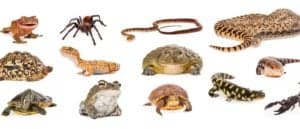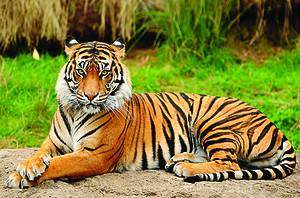Have you ever wanted to keep these fascinating shelled creatures as pets? Well, you might be wondering if they make good pets and whether they are the right pet for you. Tortoises generally make good and long-lived pets for people who enjoy a pet that isn’t very cuddly, but still requires daily care.
If you are considering getting a pet reptile like a tortoise, here’s everything you need to know to determine if they will make a good pet for you.
Can You Keep Tortoises as Pets?
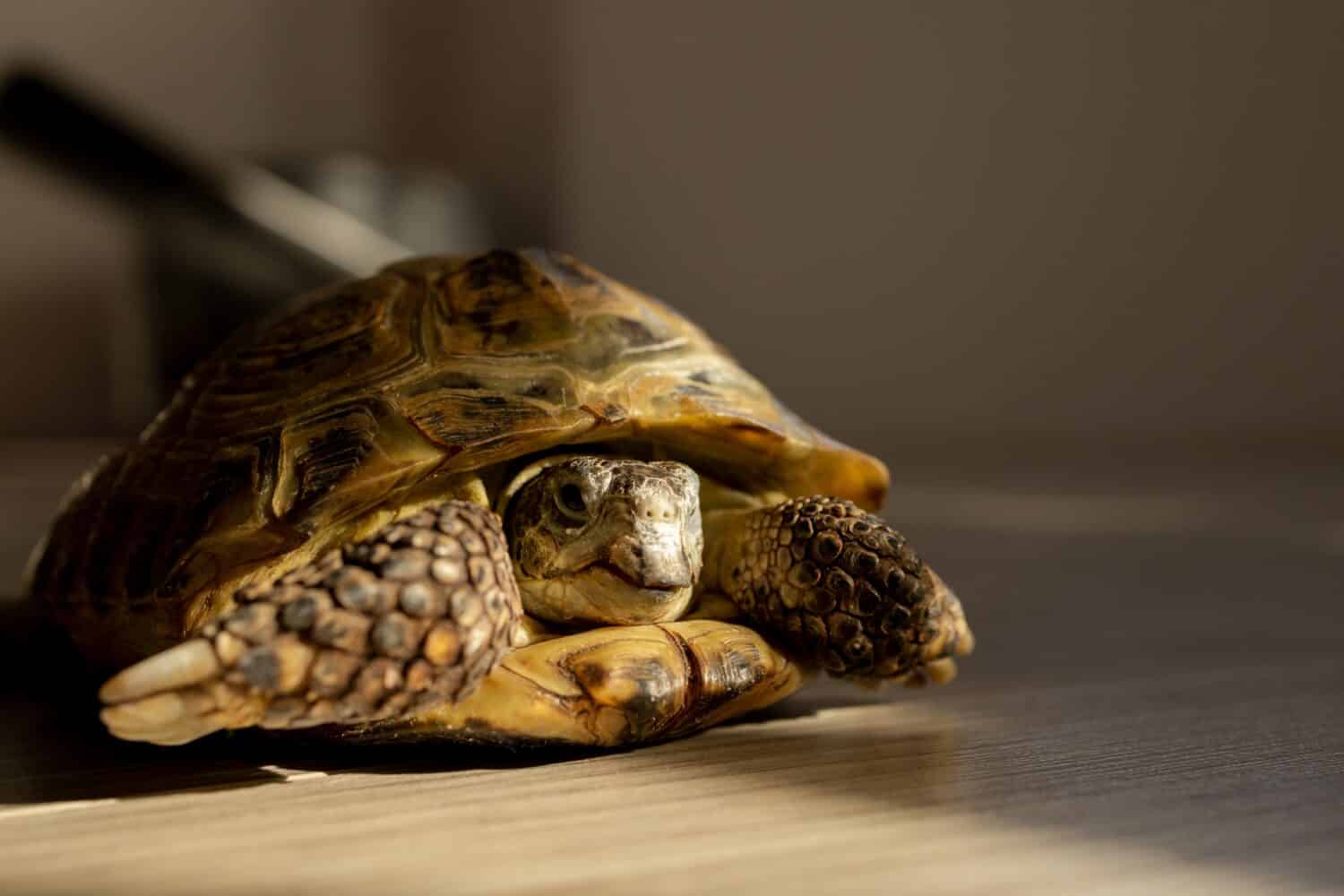
Many countries and states have
strict laws
about keeping tortoises as pets. Be sure to check the laws of your area before adopting one into your family.
©Anna List/Shutterstock.com
Tortoises can be kept as pets, but as exotic animals, there are many countries or states that have strict laws about keeping them in captivity. This is especially true for places where a tortoise is native or an endangered species. That makes it important to ensure that it is legal to keep a tortoise in your country or state.
The species of tortoise you choose will influence whether they are legal to own in your area. So, always check with official sites for your country or state to determine whether you can keep a tortoise as a pet.
You can’t go out and pick any tortoise you find out in the wild and take them home to keep them as a pet. Instead, you will need to purchase them from a responsible breeder or pet store that sells captive-bred tortoises.
Caring for a Pet Tortoise

With the maintenance of the proper care and environment, your pet tortoise can live a long and happy life.
©Juice Verve/Shutterstock.com
Tortoises will make great pets if you can care for them properly. Deciding whether a tortoise will make a good pet for you, then, means that you need to consider their care requirements.
Let’s discuss the basic care that tortoises need.
Enclosure and Maintenance
All pet tortoises will need an enclosure since it’s not a good idea to keep them in a garden or free roam where they can run into predators or escape. The enclosure will keep them safe and contain all the necessary items they need, such as food and water, substrate, hideouts, lighting, and entertainment. You can choose from an indoor or outdoor enclosure for your tortoise, but indoor enclosures are generally safer for the smaller species and ideal for raising hatchling tortoises.
The enclosure should meet the minimum size for the species, but be larger to provide your tortoise with more space to roam. In most cases, the enclosure needs to be upgraded as the tortoise grows. Further, larger species of tortoises may need to be moved to an outdoor enclosure as they get older since they grow too large to be kept indoors.
Tortoises can be quite messy, so you will need to spend a few minutes cleaning their enclosure. This means removing any poop, or soiled substrate, and wiping any surfaces your tortoise has urinated on.
Lighting
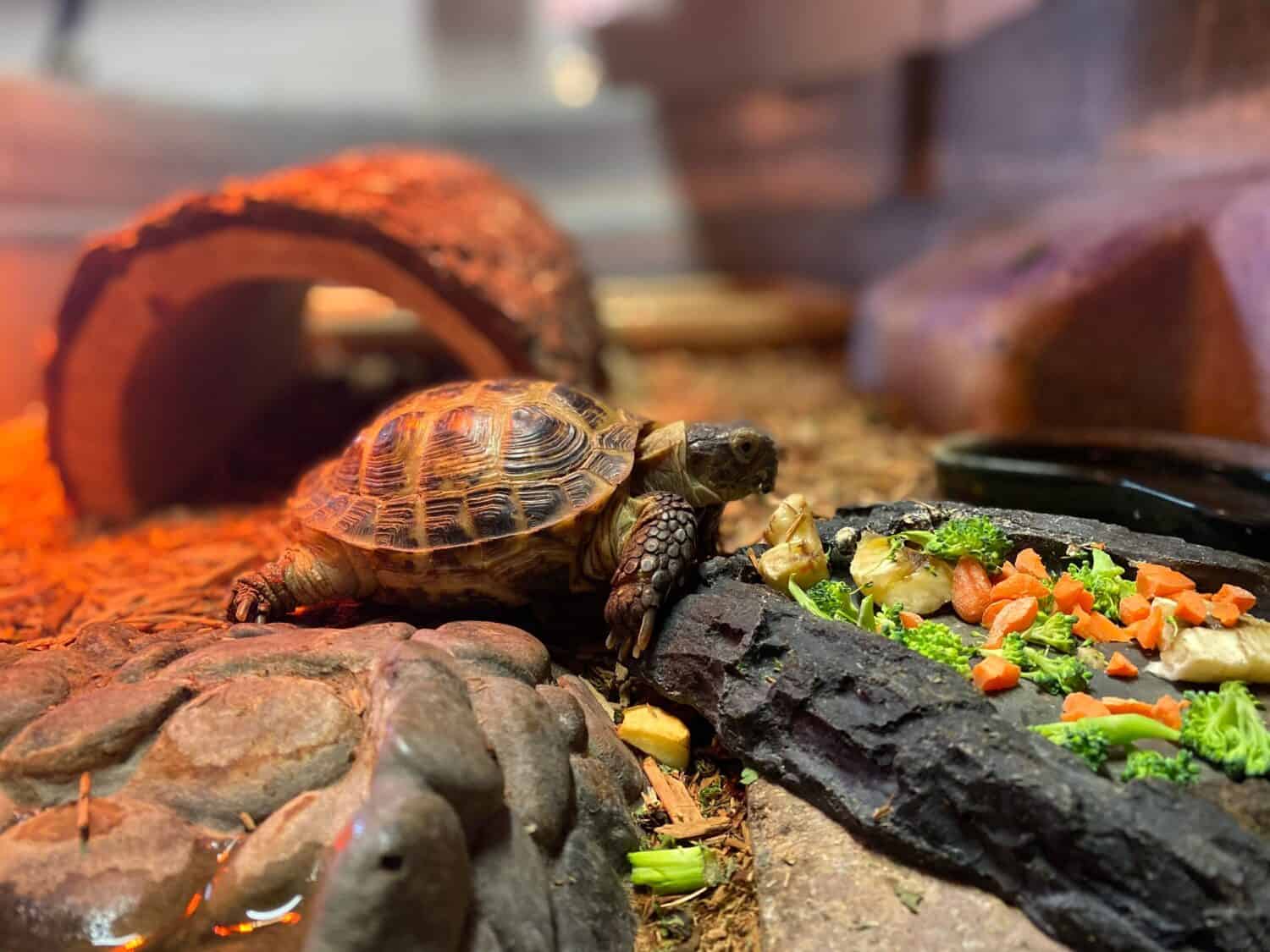
The lighting and heating of your tortoise’s terrarium are
essential.
©Wirestock Creators/Shutterstock.com
Tortoises that are kept indoors or don’t receive enough heat or light outdoors need a heating and lighting system. This is why they will bask in the sun for hours at a time in the wild. Not only does the sun provide a tortoise with much-needed warmth, but it helps them synthesize vitamin D3 that allows them to absorb calcium.
If an indoor tortoise does not have access to an artificial source of UVB and UVA, it can develop metabolic bone disease (MBD) over time. This can be prevented by using reptile lights that are designed to provide your tortoise with UV light rays. This type of lighting system usually provides heating, UV, and light at the same time, so you don’t necessarily need three different types of lights for your tortoise.
Heating
As cold-blooded reptiles, tortoises rely on external sources to keep them warm. The heat will ensure that they can regulate their body temperature and metabolize their food properly. Most tortoises will bask in the sun for a few minutes to hours, but in captivity, this isn’t always possible. This is why you will need to provide your tortoise with a heat lamp that they can bask underneath.
In a tortoise enclosure, one side should be cooler than the other without the enclosure being kept at the same constant temperature. The heat lamp will be on the warmer side and create warm basking temperatures, while the cooler side allows your tortoise to cool down to prevent overheating.
The temperature can drop gradually at night, but never lower than what is comfortable for your species of tortoise. Moreover, you should ideally keep the lighting and heating on for 8 to 10 hours a day.
Humidity
Tortoise species that are native to humid areas will require more humidity than desert-dwelling species. You can achieve a good percentage of humidity in your tortoise enclosure by misting it throughout the day. Providing your tortoise with enclosed, warm hideouts that are kept moist allows your tortoise to retreat to the hideout when they need more humidity. This helps keep your tortoises hydrated and their shell growth smooth.
However, overdoing the humidity can cause more issues than good, so don’t let your tortoise sit on a constantly wet substrate.
Diet and Supplements
A good diet will ensure that your tortoise is kept healthy and maintains an ideal weight. The diet will vary depending on the species, but all tortoises need a commercial pellet combined with fresh fruits, vegetables, and supplements. Leafy greens are also an important addition to many tortoise diets.
Some species of tortoises require more fruit or animal-based proteins in their diet, so be sure to research the type of diet your tortoise needs. Further, most tortoises require an additional source of calcium, which is important for their shell growth and maintenance. You can sprinkle calcium powder with vitamin d3 to ensure that their calcium requirements are being met.
Substrate
There are several species of pet tortoises that enjoy burrowing. In captivity, you will need to provide your tortoise with a substrate that is comfortable on their feet and allows them to burrow. This can be sandy substrates or soils that can hold more moisture, but it should be for pet reptiles and not a substrate from your garden that can carry parasites.
Depending on your species of tortoise, the substrate should be layered from 2 to 6 inches deep. You can also use waterproof cage liners on parts of your tortoise’s enclosure, especially if you find they drag their food into the substrate.
Diseases and Treatments
Like most pets, tortoises will need to be taken to a veterinarian that has experience treating tortoises when they are sick or injured. They can get sick and die if they do not receive the right help that they need, which is why a veterinarian is important. Fortunately, tortoises will rarely get sick if they are provided with the right care.
Hibernation
Hibernation is a debatable topic amongst tortoise owners. While tortoises will hibernate in the wild to survive unfavorable conditions, this survival tactic isn’t always necessary in captivity.
However, if you do plan to hibernate your pet tortoise, you will need to discuss it with their veterinarian first. A young or unhealthy tortoise won’t always survive through a hibernation period, which makes a vet check-up essential.
What To Consider Before Getting a Tortoise
- Tortoises can be a long commitment of over 50 years, so you will need to ensure that you have the right supplies, time, and money to care for them for the next couple of decades. In many cases, a well-cared-for tortoise can outlive you.
- As a fast-growing animal, tortoises may require enclosure upgrades regularly. So buying a larger enclosure from the start can be easier.
- You will need to provide your pet tortoise with fresh foods on a daily basis aside from commercial food.
- The larger species of tortoises can be destructive to gardens and indoor areas, so keep this in mind when designing their enclosure.
- Tortoises aren’t the cheapest pets and can be quite expensive to maintain. A tortoise’s enclosure and accessories will be pricey, and any heating lamps and lighting will consume electricity every day. You will also need to put money aside for their fresh foods and any unexpected vet visits.
- Since tortoises require humidity, you will need to regularly mist their enclosure during the day which can be time-consuming.
- Tortoises don’t enjoy being cuddled or want to sit on the couch with you while you watch television, but they will explore and search for food. While some tortoises can be shy, many tortoises will enjoy interacting with you and readily accept any food you are offering them from your hand.
7 Types of Tortoises You Can Keep As Pets
There are a variety of different pet tortoises you can choose from, each with a different lifespan and adult size. Although most tortoises have similar care requirements, there are noticeable differences between each species’ needs. This is worth considering if you want to see which species of tortoise will make a good pet for you.
1. Sulcata Tortoise (Geochelone sulcata)
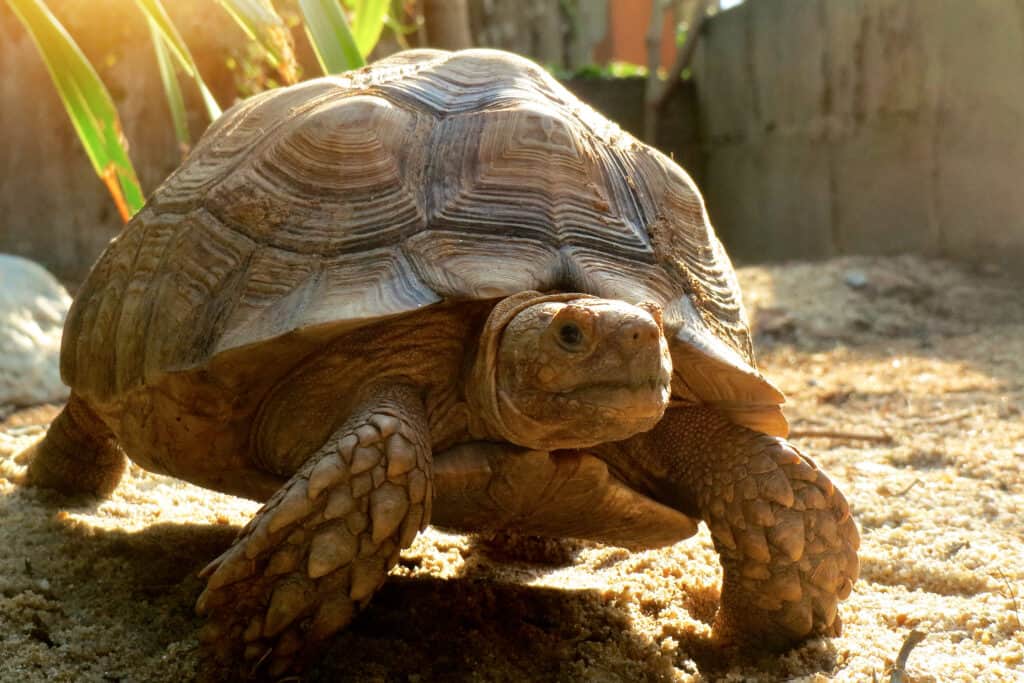
Sulcata tortoises are one of the largest tortoises you can keep as a pet.
©seasoning_17/Shutterstock.com
| Size: | 25 to 30 inches |
| Diet: | Herbivore |
| Lifespan: | 80 to 100 years |
| Enclosure size: | 10×11 square feet |
The sulcata is by far one of the largest tortoises that you can keep as a pet. These tortoises can grow up to 30 inches in size and weigh over 100 pounds. While these tortoises look small and cute when they are hatchlings, they grow extremely large and can become overwhelming to look after.
Since they are used to arid desert environments, sulcata tortoises aren’t very fussy over humidity. They do need a much larger enclosure than other species as hatchlings and juveniles, but they will need to be moved to an extremely large outdoor enclosure when they are older.
2. Russian Tortoise (Agrionemys horsfieldii)
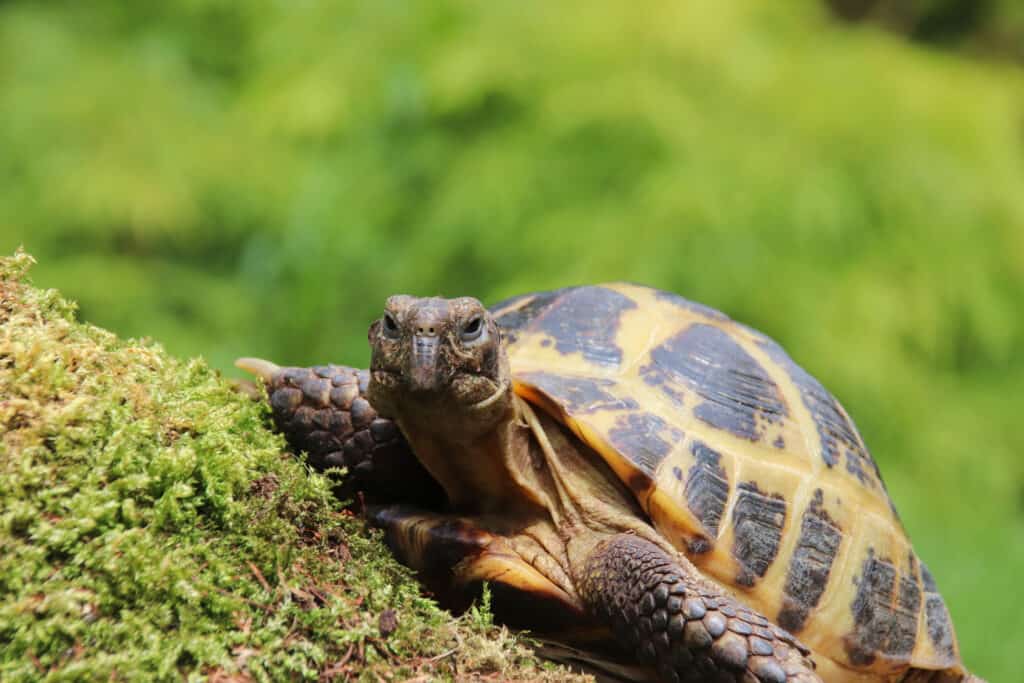
Because Russian tortoises are desert dwellers, their humidity requirements aren’t particularly demanding.
©Haoss/Shutterstock.com
| Size: | 8 to 10 inches |
| Diet: | Herbivore |
| Lifespan: | 40 years |
| Enclosure size: | 2×4 feet |
The Russian tortoise is a small species of tortoise that can be found in grasslands or deserts. They are avid burrowers that love to dig since they will burrow to escape the harsh weather conditions in the wild. This means that your Russian tortoise requires at least 3 inches of sandy substrate to burrow in.
Their smaller size makes it easier to keep a Russian tortoise in a small indoor enclosure. As a desert-dwelling species, Russian tortoises don’t have very demanding humidity requirements. They have a simple yellow and black pattern on their shell, with a rounded appearance when viewed from above.
3. Indian Star Tortoise (Geochelone elegans)
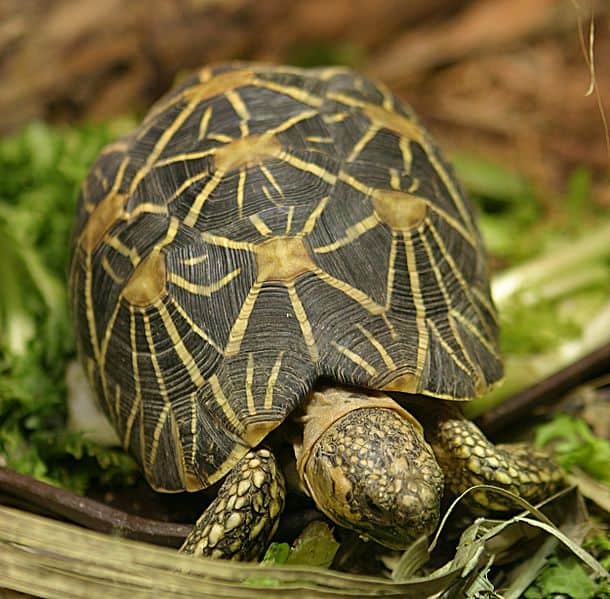
Indian star tortoises are not as territorial as some species, making them a good fit for being kept together.
©Cburnett, CC BY-SA 3.0, via Wikimedia Commons – License
| Size: | 7 to 12 inches |
| Diet: | Herbivore |
| Lifespan: | Up to 80 years |
| Enclosure size: | 6×6 feet |
The endangered Indian star tortoise has a fascinating pattern on their shell and a small size that makes them a popular pet. They enjoy more humidity in their environment during the summer and drier winters. An Indian star tortoise can be kept in same-sex groups since they are not as territorial as other species of tortoise. So, if you are looking to keep a group of small tortoises together, then Indian star tortoises are worth considering.
4. Leopard Tortoise (Stigmochelys pardalis)
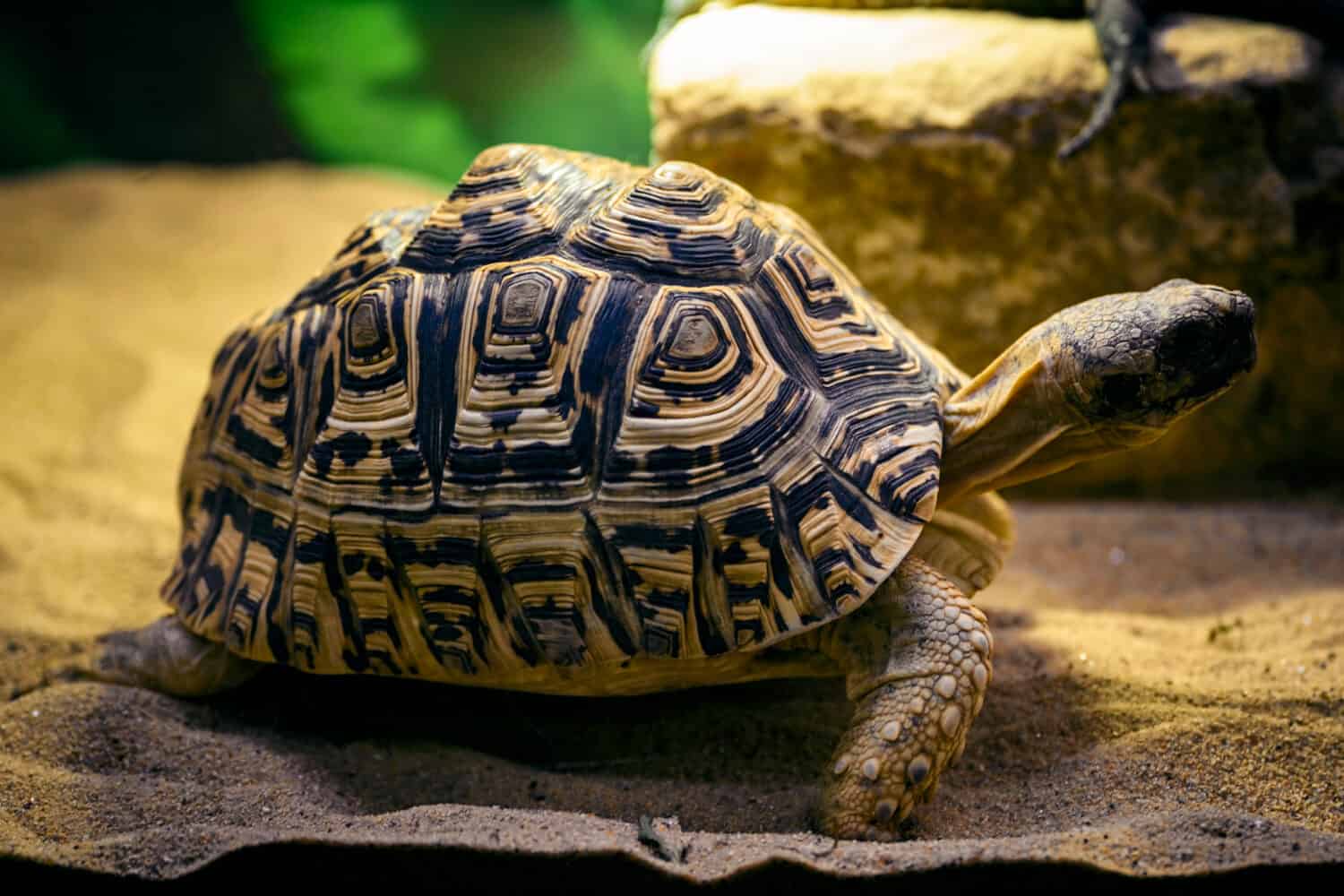
Leopard tortoises are best in conditions replicating dry savannahs and grasslands of
Africa
.
©Lapis2380/Shutterstock.com
| Size: | 16 to 28 inches |
| Diet: | Herbivore |
| Lifespan: | 50 to 100 years |
| Enclosure size: | 10×10 feet |
Much like the sulcata tortoise, the leopard tortoise is capable of reaching very large sizes. They have been named for the leopard-like patterns on their bodies which look quite striking. Due to their size, the leopard tortoise requires a big enclosure that gives them enough space to roam.
They benefit from a combination of soils that retain water well, along with sandy substrates that allow them to dig and burrow. A leopard tortoise has adapted to the hot and dry savannahs and grasslands in Africa, and they do best when these conditions are replicated in captivity.
5. Red-Footed Tortoise (Chelonoidis carbonaria)

If you keep a red-footed tortoise, use good moisture-retaining soil to help maintain the tortoise’s humidity levels.
©Seregraff/Shutterstock.com
| Size: | 12 to 16 inches |
| Diet: | Omnivore |
| Lifespan: | Up to 50 years |
| Enclosure size: | 6×6 feet |
One of the most popular pet tortoises you can keep is the red-footed tortoise. These tortoises can be found inhabiting forests and savannahs where there are high levels of humidity. In captivity, a red-footed tortoise requires between 70% to 80% humidity which can be achieved by warm temperatures and regular misting.
Good moisture-retaining soil is also helpful in keeping this tortoise’s humidity levels up. Aside from making a popular pet tortoise, they have an interesting color of black and yellow with red marks on their bodies.
6. Greek Tortoise (Testudo graeca)
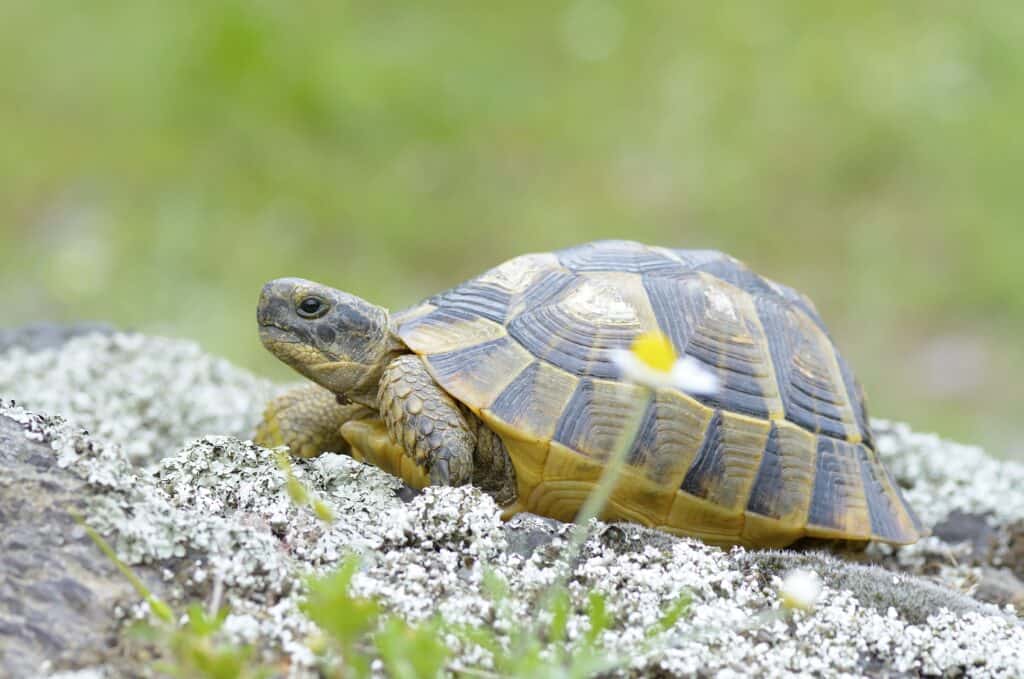
With their smaller size, Greek tortoises do well in indoor enclosures.
©iStock.com/Remus86
| Size: | 8 to 11 inches |
| Diet: | Herbivore |
| Lifespan: | Over 100 years |
| Enclosure size: | 3×6 feet |
The Greek or spur-thighed tortoise is on the smaller side, which means they can do well in an indoor enclosure. These tortoises are known for their very long lifespans and often reaching 125 years of age. Greek tortoises have a simple pattern on their shells of yellow, black, and brown. In captivity, a Greek tortoise is fairly easy to care for and enjoys a diet high in fiber provided by leafy greens.
7. Hermann’s Tortoise (Testudo hermanni)

Hermann’s tortoises are another smaller option, usually ranging between 6 and 10 inches.
©Predrague/Shutterstock.com
| Size: | 6 to 10 inches |
| Diet: | Herbivore |
| Lifespan: | Up to 75 years |
| Enclosure size: | 2×4 feet |
If you are interested in keeping a pet tortoise that is going to stay small, then a Hermann’s tortoise is worth considering. The Hermann’s tortoise is categorized into two different subspecies – the eastern (T. h. hermanni) and western (T. h. boettgeri) Hermann tortoise.
These small yet long-lived tortoises can be kept indoors where they spend most of their day basking, sleeping, and munching on food. These tortoises inhabit forests and grasslands, so they require a moderate level of humidity and a herbivorous diet.
Are Tortoises the Right Pet for You?
Tortoises make good pets for people who can provide them with the necessary care and look after a pet that has an extremely long lifespan, generally over 50 years. If you think you can maintain the proper care, heating, lighting, space, and other requirements tortoises have, then they can be a good friend and family member for a lifetime.
The photo featured at the top of this post is © chrisbrignell/Shutterstock.com
Thank you for reading! Have some feedback for us? Contact the AZ Animals editorial team.



